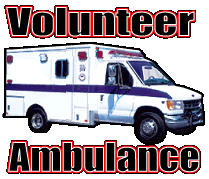Bergen County will launch a paid ambulance corps to augment overworked volunteers in busy boroughs
 The plan is to use ambulances from county training facilities, staff them with salaried emergency medical technicians, and dispatch them to towns when local EMTs are not available, County Executive Dennis McNerney said.
The plan is to use ambulances from county training facilities, staff them with salaried emergency medical technicians, and dispatch them to towns when local EMTs are not available, County Executive Dennis McNerney said.To pay the EMTs, the county will bill the insurance companies of the patients they treat, McNerney said.
 "No way is this a county takeover," McNerney said in an interview. "We're not saying [to volunteer EMTs].We're going to take over your ambulance.' We want to work hand in hand" with them, he said.
"No way is this a county takeover," McNerney said in an interview. "We're not saying [to volunteer EMTs].We're going to take over your ambulance.' We want to work hand in hand" with them, he said.The move follows a state report last fall that found New Jersey's system of 25,000 volunteer and professional emergency medical responders to be in "near crisis" and in need of statewide coordination. Volunteer services in North Jersey are continually suffering from a manpower shortage, the report said.Robert RiccardellaMcNerney's chief of staff, said he was disappointed state health officials haven't acted on any of the report's suggestions. "The state report was great, but we're not going to wait for them," he said. "We have immediate needs, now.
 The proposed county system, expected to start before spring, has been discussed since 2006, McNerney said. But the need has become more urgent since the closing of Pascack Valley Hospital in Westwood, which has strained volunteer EMT service in several towns, he said. Ambulance crews in the area are working more hours because they're driving longer round trips through traffic to reach hospitals.
The proposed county system, expected to start before spring, has been discussed since 2006, McNerney said. But the need has become more urgent since the closing of Pascack Valley Hospital in Westwood, which has strained volunteer EMT service in several towns, he said. Ambulance crews in the area are working more hours because they're driving longer round trips through traffic to reach hospitals. "It's very hard on the volunteers," Riccardella said. "We're seeing it countywide. They need someone, not to take over, but to assist, particularly during the daytime."
"It's very hard on the volunteers," Riccardella said. "We're seeing it countywide. They need someone, not to take over, but to assist, particularly during the daytime."The county will use a $100,000 grant from the New Jersey Department of Community Affairs to cover start-up costs, McNerney said. The county already owns eight ambulances, which it uses to train EMTs. It needs a state license to use the vehicles for hospital runs.
The service will be operated by the county Department of Public Safety. The county plans to use two or three of its ambulances, adding more if necessary, Riccardella said.
Bill Kroepke, who has served as a volunteer EMT for the past 39 years, opposes a paid county ambulance service. He believes volunteers can handle the job.
"Personally, I'm against it," said Kroepke, president of the Pascack Valley Volunteer Ambulance Association(link), which includes 21 municipalities.
"Up here in the Pascack Valley area, we're doing quite well by our cooperative mutual aid agreement," said Kroepke, who is also captain of the Washington Township Volunteer Ambulance Corps,(Link) and coordinator of the Pascack Valley Mutual Aid Group of seven towns, including Westwood, where Pascack Valley Hospital was located.
"Very seldom do we run short of rigs," he said. "We're stretched, but we're holding our own."
However, he acknowledged that some towns would welcome the county's help "because it takes the heat off their lack of membership."
Gloucester County is the only county in the state with paid EMTs. Its service began in 2007, said Tom Slater, spokesman for the New Jersey Department of Health and Senior Services.
Some municipalities in Bergen County already have paid EMTs in addition to volunteers. Paramus switched to this type of "hybrid" ambulance service last January to get rescue workers to emergencies more quickly, said Mayor James Tedesco.

"We had a response time problem – not a quality of care problem, but a response problem -- especially during the daytime," Tedesco said.
The new system has "greatly improved" response time, Tedesco said. Paid EMTs can go directly to the scene, unlike volunteers who have to leave home or business to first pick up an ambulance, he said.
Before paying their EMTs, Paramus could not recruit enough volunteers to meet the demand of emergency calls, Tedesco said. Paramus EMTs earn $12 an hour, on a par with those at local hospitals, he said. Under the hybrid system, the EMTs may work voluntarily, paid an hourly wage, or do a combination of both, he said.
"Volunteerism is extremely important," said Tedesco, a volunteer fire chief for 30 years. "For me, this was a way to keep volunteerism alive and well, but also meet our fiduciary responsibility, by providing hourly employees."
The borough projects that third-party billing, not taxpayers, will cover the costs of providing the EMT services, Tedesco said. Sixty percent of the patients transported by ambulance in Paramus are non-residents who are there shopping, or just driving through, he said.
Fair Lawn used to rely on mutual aid with Hawthornefor additional EMTs, but decided to supplement its volunteers with a private commercial ambulance service in 2006, said Borough Manager Tom Metzler.
The 60 Fair Lawn volunteers,(Link) who take 80 percent of ambulance calls, at first resented the idea of hiring paid EMTs, Metzler said.
"This is a normal human reaction," he said. "Perhaps they felt threatened that we'd eliminate volunteers, or were reluctant to acknowledge" that they needed help, he said. By last year, however, they were in favor of it, he said.
"Let me tell you, dollar for dollar, shared services has worked for us.























No comments:
Post a Comment